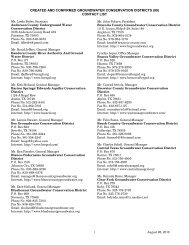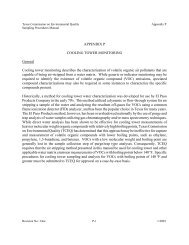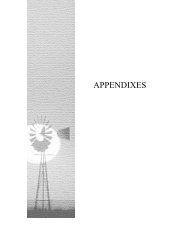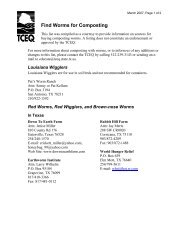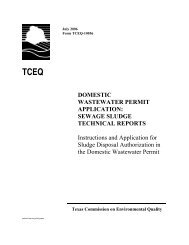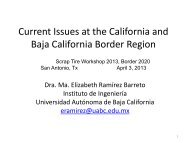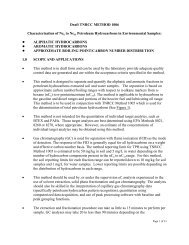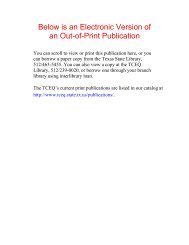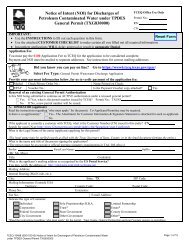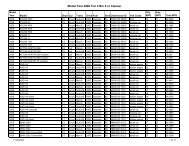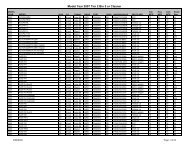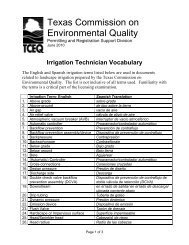The headwater catfish (Ictalurus lupus), found in Independence Creek, is <strong>on</strong>e<str<strong>on</strong>g>of</str<strong>on</strong>g> several fish species <str<strong>on</strong>g>of</str<strong>on</strong>g> c<strong>on</strong>cern that depend <strong>on</strong> spring-fed stream systemsfor their existence. Photo: Garold Sneegas, <str<strong>on</strong>g>Texas</str<strong>on</strong>g> Natural History Collecti<strong>on</strong>sshiner (Cyprinella proserpina), Rio Grande darter (Etheostoma grahami),and headwater catfish (Ictalurus lupus) (B<strong>on</strong>ner et al., 2004; Linam et al.,2002).With the intensive year round grazing and overstocking comm<strong>on</strong> at theend <str<strong>on</strong>g>of</str<strong>on</strong>g> the 19 th century, woody shrubs began to increase in density <strong>on</strong> theStockt<strong>on</strong> Plateau as they did elsewhere in both east and west <str<strong>on</strong>g>Texas</str<strong>on</strong>g>. Today,the mesa tops are sparsely covered by h<strong>on</strong>ey mesquite brush (Prosopisglandulosa), redberry juniper (Juniperus pinchotii) in the north and west, and Ashe juniper (J. ashei) inthe east and south. Mohr oak (Quercus mohriana) and Vasey oak (Q. vaseyana), both shrubby in growthform, replace plateau live oak (Q. fusiformis) that is comm<strong>on</strong> <strong>on</strong> the Edwards Plateau (30) to the east. Thelower elevati<strong>on</strong>s <strong>on</strong> the Stockt<strong>on</strong> Plateau are covered with grama grasses (Bouteloua spp.) and ChihuahuanDesert shrubs, such as yucca (Yucca spp.), sotol (Dasyliri<strong>on</strong> spp.), and lechuguilla (Agave lechuguilla).Broomweeds (Amphiachyris and Gutierrezia spp.), tasajillo (Opuntia leptocaulis), pricklypear (Opuntiaspp.), and burrograss (Scleropog<strong>on</strong> brevifolius) are comm<strong>on</strong> <strong>on</strong> overgrazed ranges (Bezans<strong>on</strong> 2000, <str<strong>on</strong>g>Texas</str<strong>on</strong>g>A&M Bi<str<strong>on</strong>g>of</str<strong>on</strong>g>ormatics Working Group <str<strong>on</strong>g>199</str<strong>on</strong>g>6).Level IV Ecoregi<strong>on</strong>24e. Stockt<strong>on</strong> PlateauArea (sq. mi.) 3369PhysiographyPlateau with mesa topography. Most streams ephemeral; scattered springs. Streamsubstrate bedrock, cobble, or gravel.Elevati<strong>on</strong> /Local Relief (feet)1700-4900 /300-700Holocene and Pleistocene clay loam residuum and colluvium mixed with limest<strong>on</strong>eSurficial Geology;Bedrock Geologyshards and st<strong>on</strong>es; Holocene and Pleistocene gravels and sands in drainages.Lower Cretaceous limest<strong>on</strong>es and dolomite <str<strong>on</strong>g>of</str<strong>on</strong>g> the Edwards Formati<strong>on</strong>; UpperCretaceous limest<strong>on</strong>es <str<strong>on</strong>g>of</str<strong>on</strong>g> the Buda and Boquillas formati<strong>on</strong>s cap higher hills and buttes.Soil Order (Great Groups)Mollisols (Haplustolls, Calciustolls), Aridisols (Haplocalcids, Haplocambids,Petrocalcids)Comm<strong>on</strong> Soil SeriesLimest<strong>on</strong>e plains and plateaus: Ector; Kavett, Tarrant, Valera. Alluvial flats andfloodplains: Dev, Reagan, Sanders<strong>on</strong>, Upt<strong>on</strong>. Rock outcrop.Soil Temperature /Soil Moisture RegimesThermic /Ustic, AridicMean Annual Precipitati<strong>on</strong> (in.) 14-18Mean Annual Frost Free Days 220-240Mean Temperature (F)(Jan. min/max; July min/max)31/60;70/95Mesas: Ashe or redberry juniper, Vasey or Mohr oak brush, h<strong>on</strong>ey mesquite,Vegetati<strong>on</strong>lotebush. Lower elevati<strong>on</strong>s: yucca, sotol, lechuguilla, tarbush, grama and muhlygrasses. Riparian vegetati<strong>on</strong>: plateau live oak, little walnut, desert willow, and aliensaltcedar.Land Cover and Land Use Mostly shrubland, some grassland. Ranching, grazing, wildlife habitat.Cave explorerspr<str<strong>on</strong>g>of</str<strong>on</strong>g>icient in rappellingdown vertical shaftsexplore the SirianRiver at the bottom<str<strong>on</strong>g>of</str<strong>on</strong>g> Sorcerer’s Cave,500 feet below theStockt<strong>on</strong> Plateau.Photo: Chris VreelandThe Pecos River flows al<strong>on</strong>g the eastern boundary <str<strong>on</strong>g>of</str<strong>on</strong>g> the Stockt<strong>on</strong> Plateauecoregi<strong>on</strong> (24e). Photo: R.E. Rosiere, Tarlet<strong>on</strong> State University<str<strong>on</strong>g>Ecoregi<strong>on</strong>s</str<strong>on</strong>g> <str<strong>on</strong>g>of</str<strong>on</strong>g> <str<strong>on</strong>g>Texas</str<strong>on</strong>g> 17
1825 High PlainsThe High Plains ecoregi<strong>on</strong> is higher and drier than the Central Great Plains (27) to the east. And, in c<strong>on</strong>trastto the characteristic irregular rangeland <str<strong>on</strong>g>of</str<strong>on</strong>g> the Northwestern Great Plains (43) to the north in the Dakotasand eastern M<strong>on</strong>tana and Wyoming, much <str<strong>on</strong>g>of</str<strong>on</strong>g> the High Plains is expressed as smooth to slightly irregularplains with a high percentage <str<strong>on</strong>g>of</str<strong>on</strong>g> cropland. The potential natural vegetati<strong>on</strong> in this regi<strong>on</strong> is grama-buffalograss compared to mostly wheatgrass-needlegrass to the north, Trans-Pecos shrub savanna to the south, andtallgrass prairie to the east (Kuchler 1964, 1970). The northern boundary <str<strong>on</strong>g>of</str<strong>on</strong>g> this ecological regi<strong>on</strong> is also theapproximate northern limit <str<strong>on</strong>g>of</str<strong>on</strong>g> winter wheat and sorghum and the southern limit <str<strong>on</strong>g>of</str<strong>on</strong>g> spring wheat. The ecoregi<strong>on</strong>includes the plains area <str<strong>on</strong>g>of</str<strong>on</strong>g> the Llano Estacado. Thousands <str<strong>on</strong>g>of</str<strong>on</strong>g> playa lakes (seas<strong>on</strong>al depressi<strong>on</strong>al wetlands)occur in this area, many serving as recharge areas for the important Ogallala Aquifer. These playa lakes arealso essential for waterfowl during their yearly migrati<strong>on</strong> al<strong>on</strong>g the Central Flyway <str<strong>on</strong>g>of</str<strong>on</strong>g> North America. Oil andgas producti<strong>on</strong> occurs in many parts <str<strong>on</strong>g>of</str<strong>on</strong>g> the regi<strong>on</strong>.25b Rolling Sand PlainsThe Rolling Sand Plains expand northward from the lip <str<strong>on</strong>g>of</str<strong>on</strong>g> the Canadian River trough,and they are topographically expressed as flat sandy plains or rolling dunes. Ecoregi<strong>on</strong>25b is similar to the Canadian-Cimarr<strong>on</strong> High Plains (25e) in that it has a more northerlyclimate with colder, more snowy winters than the rest <str<strong>on</strong>g>of</str<strong>on</strong>g> the Llano Estacado (25i) tothe south <str<strong>on</strong>g>of</str<strong>on</strong>g> the Canadian River. The vegetative cover <str<strong>on</strong>g>of</str<strong>on</strong>g> the Rolling Sand Plains istransiti<strong>on</strong>al between the Shinnery Sands (25j) to the south and the sandsage prairies <str<strong>on</strong>g>of</str<strong>on</strong>g>Oklahoma and Kansas (northerly disjunct polyg<strong>on</strong>s <str<strong>on</strong>g>of</str<strong>on</strong>g> Ecoregi<strong>on</strong> 25b). Havard shin oak (Quercus havardii),the characteristic shrub cover <str<strong>on</strong>g>of</str<strong>on</strong>g> the Shinnery Sands (Ecoregi<strong>on</strong> 25j), still grows in the <str<strong>on</strong>g>Texas</str<strong>on</strong>g> porti<strong>on</strong> <str<strong>on</strong>g>of</str<strong>on</strong>g>Ecoregi<strong>on</strong> 25b, but it is at the northern limit <str<strong>on</strong>g>of</str<strong>on</strong>g> its distributi<strong>on</strong>.However, both Havard shin oak and sand sagebrush (Artemisiafilifolia) perform the same important functi<strong>on</strong> <str<strong>on</strong>g>of</str<strong>on</strong>g> stabilizingsandy areas subject to wind erosi<strong>on</strong>.The boundaries for the Rolling Sand Plains were delineatedthrough a c<strong>on</strong>juncti<strong>on</strong> <str<strong>on</strong>g>of</str<strong>on</strong>g> the mapped sandsage associati<strong>on</strong> <strong>on</strong>vegetati<strong>on</strong> maps and the soil maps and descripti<strong>on</strong>s that identifiedtypically sandy soil associati<strong>on</strong>s (USDA NRCS <str<strong>on</strong>g>199</str<strong>on</strong>g>4). Thesesandy areas were also corroborated <strong>on</strong> topographical maps asareas that had a more random and irregular road network, ratherthan the rectangular grid that is comm<strong>on</strong> in agricultural areas.The sandsage associati<strong>on</strong> includes grasses such as big The sand shinnery (Quercus mohriana, Artemisiafilifolia) community protects the Rolling Sand Plainssandreed (Calamovilfa gigantea), little bluestem (Schizachyrium from wind erosi<strong>on</strong> by vegetating the loose sandscoparium), sand dropseed (Sporobolus cryptandrus), and sand substrate. The rolling dune topography is visible in thebluestem (Andropog<strong>on</strong> gerardii). Other native range plants are background. Photo: R.E. Rosiere, Tarlet<strong>on</strong> State University.blue grama (Bouteloua gracilis), sideoats grama (Boutelouacurtipendula), buffalograss (Buchloe dactyloides), switchgrass (Panicum virgatum),yellow Indiangrass (Sorghastrum nutans), and yucca (Yucca spp.). The soils <str<strong>on</strong>g>of</str<strong>on</strong>g> theRolling Sand Plains have a mesic temperature regime in c<strong>on</strong>trast to the thermictemperature regime <str<strong>on</strong>g>of</str<strong>on</strong>g> soil in the Llano Estacado (25i) south <str<strong>on</strong>g>of</str<strong>on</strong>g> the Canadian River.Coarse textured sandy soils typically remain in native rangeland. Soils that are moreloamy or clayey may be tilled and planted with wheat or grain sorghum. The goal<str<strong>on</strong>g>of</str<strong>on</strong>g> both agricultural and grazing management is to keep enough vegetative cover <strong>on</strong>the land surface to minimize wind erosi<strong>on</strong>.The drainage density <str<strong>on</strong>g>of</str<strong>on</strong>g> the regi<strong>on</strong> is low, but thesandy surface serves as a recharge area for a minorgroundwater aquifer that feeds a few widely spaced<str<strong>on</strong>g>Ecoregi<strong>on</strong>s</str<strong>on</strong>g> <str<strong>on</strong>g>of</str<strong>on</strong>g> <str<strong>on</strong>g>Texas</str<strong>on</strong>g>The sand dropseed (Sporoboluscryptandrus) is a bunchgrassthat grows in the coarse sands<str<strong>on</strong>g>of</str<strong>on</strong>g> Ecoregi<strong>on</strong> 25b. Photo: R.E.Rosiere, Tarlet<strong>on</strong> State University
- Page 1: Below is an Electronic Version <str
- Page 4 and 5: ECOREGIONS OF TEXAS</strong
- Page 6 and 7: TABLE OF CONTENTSABSTRACT..........
- Page 8 and 9: 2526272526272330293235332430323423
- Page 10 and 11: INTRODUCTIONSpatial frameworks are
- Page 12 and 13: Maps of environmen
- Page 14 and 15: vegetation or small areas o
- Page 16 and 17: the only chipmunk in Texas<
- Page 18 and 19: to the north. There is a high deman
- Page 20 and 21: taller, coarser tobosa grass (Pleur
- Page 22 and 23: the fractured rock. The Bof
- Page 24 and 25: hollows, moving upslope to create c
- Page 28 and 29: streams. Two sand plains streams, C
- Page 30 and 31: Several caliche horizons (calcium c
- Page 32 and 33: winds (Spearing 199</strong
- Page 34 and 35: Geology is an important geographica
- Page 36 and 37: the villages of Pa
- Page 38 and 39: Area (sq. mi.) 5569PhysiographyFlat
- Page 40 and 41: Tableland topography of</st
- Page 42: y the Brazos and Colorado rivers ha
- Page 45 and 46: Level IV Ecoregion27i. Broken Red P
- Page 47 and 48: Post oaks (Quercus stellata) and bl
- Page 49 and 50: Level IV Ecoregion29c. Western Cros
- Page 51 and 52: than the limestone of</stro
- Page 53 and 54: underlying the sandstone. This has
- Page 55 and 56: Since settlement, many wildlife spe
- Page 57 and 58: (Pellaeae spp.), Nuttall’s stonec
- Page 59 and 60: Trinity-Edwards aquifer, discharges
- Page 61 and 62: Edwards Plateau to savanna-like con
- Page 63 and 64: species list, prefers fast moving w
- Page 65 and 66: Level IV Ecoregion31a. Northern Nue
- Page 67 and 68: 31c Texas-Tamaulip
- Page 69 and 70: 31d Rio Grande Floodplain and Terra
- Page 71 and 72: 62shrink when dry and swell when we
- Page 73 and 74: 32b Southern Blackland PrairieThe S
- Page 75 and 76: 33 EAST CENTRAL TE
- Page 77 and 78:
and need some patchy distubances an
- Page 79 and 80:
33d Northern Prairie OutliersThe sm
- Page 81 and 82:
Level IV Ecoregion33e. Bastrop Lost
- Page 83 and 84:
34a Northern Humid Gulf Coastal Pra
- Page 85 and 86:
34b Southern Subhumid Gulf Coastal
- Page 87 and 88:
occasional discontinuous drainage r
- Page 89 and 90:
oundary was the ability to match th
- Page 91 and 92:
Level IV Ecoregion34f. Lower Rio Gr
- Page 93 and 94:
live oak trees (Quercus virginiana)
- Page 95 and 96:
Shoal grass (Halodule wrightii) mea
- Page 97 and 98:
Upland oak-pine forest in Ecoregion
- Page 99 and 100:
35c Pleistocene Fluvial TerracesThe
- Page 101 and 102:
35f FlatwoodsMostly flat to gently
- Page 103 and 104:
pasture, although some woodland sti
- Page 105 and 106:
invariant definition of</st
- Page 107 and 108:
how many stream sites/watersheds ar
- Page 109 and 110:
commonly believed. Typically, about
- Page 111 and 112:
CONCLUSIONS AND RECOMMENDATIONSThis
- Page 113 and 114:
104Ecoregions <str
- Page 115 and 116:
Biggs, B.J.F., M.J. Duncan, I.G. Jo
- Page 117 and 118:
Diggs, G.M., Jr., and P.C. Schulze.
- Page 119 and 120:
Graves, J. 2002. Texas</str
- Page 121 and 122:
Hunt, C.B. 1967. Physiography <stro
- Page 123 and 124:
Maxwell, T.C. 1979. Avifauna <stron
- Page 125 and 126:
Richmond, G.M., D.L. Weide, and D.W
- Page 127 and 128:
U.S. Department of
- Page 129 and 130:
Woods, A.J., J.M. Omernik, D.R. But
- Page 131 and 132:
Herbaceous Plants(Forbs, Grasses, a
- Page 133 and 134:
Hickory, BlackHickory, WaterHollyHu



